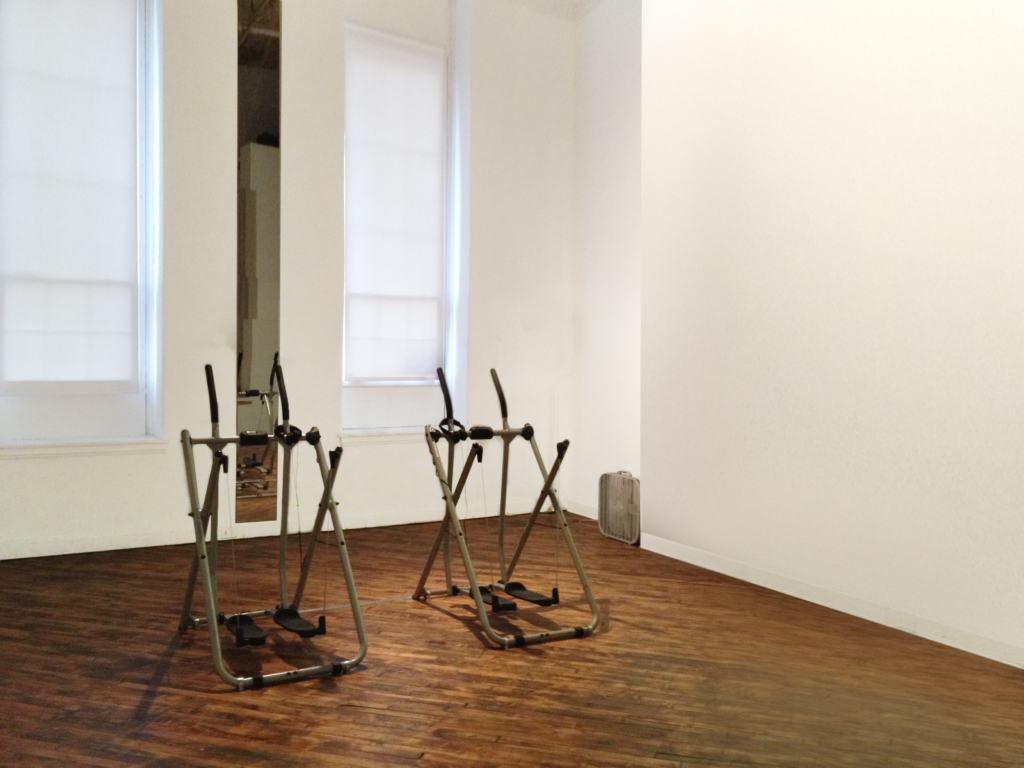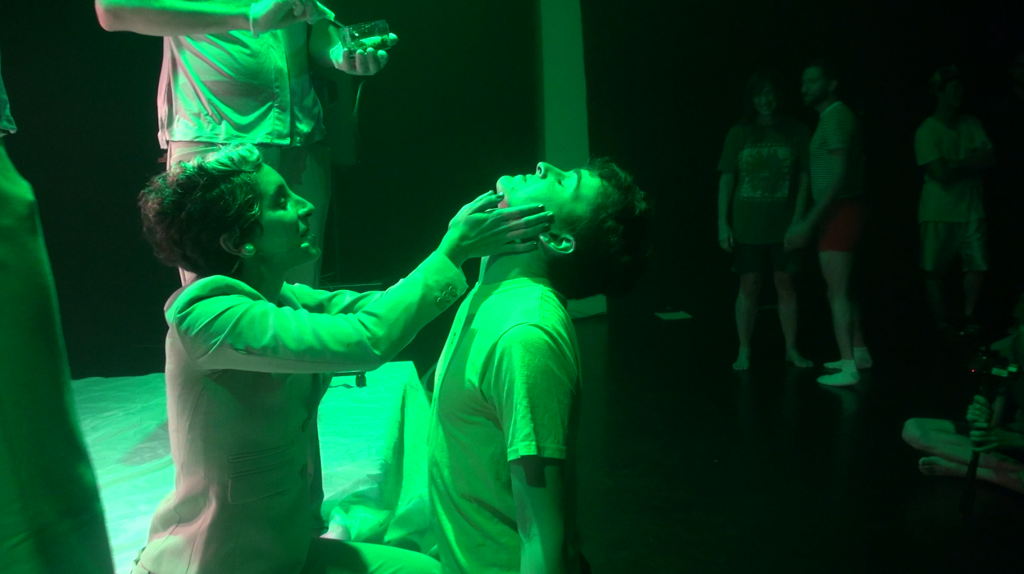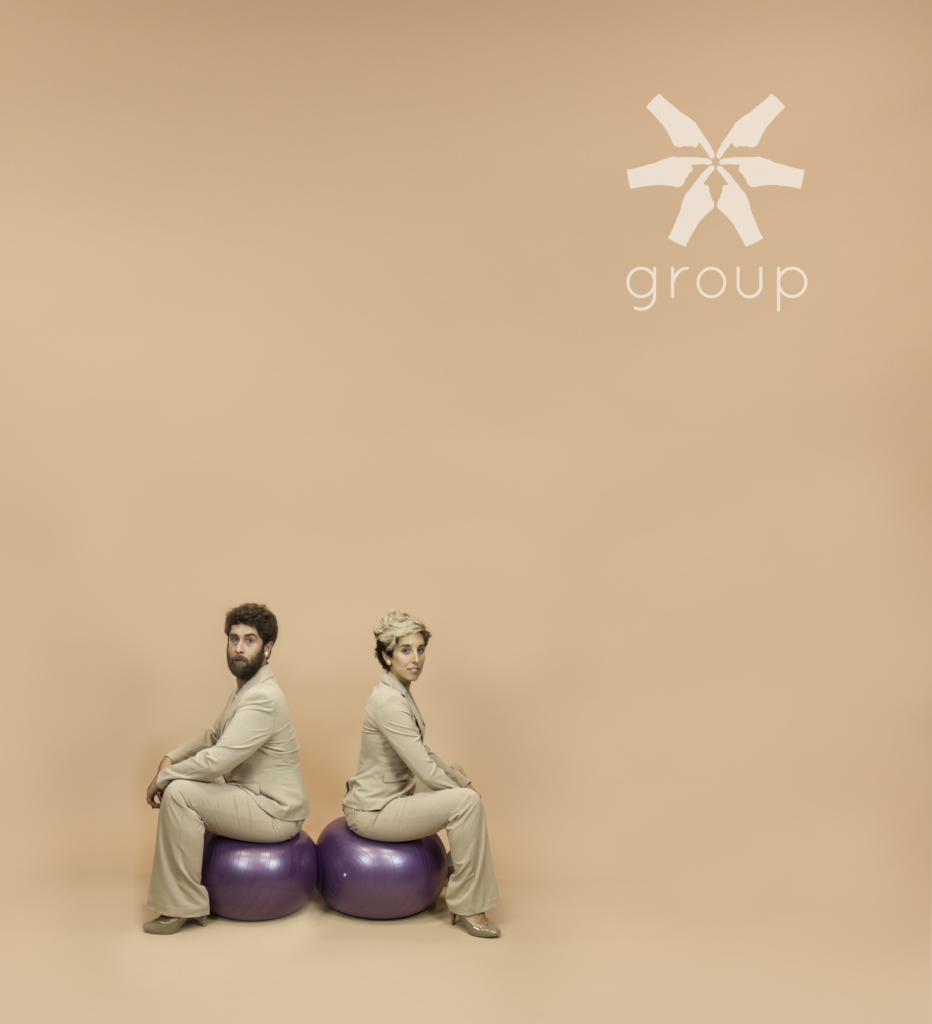When I happened in on PRACTICE gallery on a recent evening of art openings in Philadelphia, I had the predictable reaction to a piece that requires a little bit of input from the consumer side. It was Friday, there were people all around, and I didn’t feel like putting on headphones and walking on a treadmill for seven minutes. I’d rather drink some beer and have a chat — the old familiar art opening activities.
But eventually curiosity got the best of me, and I found the awkward but soothing experience of walking slowly in place to the sound of a woman’s steady instructions, of looking hesitantly into the eyes of a stranger through a carefully placed mirror, to be the most distinctive social interaction I had all evening. The piece, “Walk Together” by the Institute for New Feeling, opened up a quiet space of hazy connection in the Friday night cacophony.
This is what the Institute for New Feeling — an artist collective led by Scott Andrew, Agnes Bolt, and Nina Sarnelle — does. They create situations, interactions, moments of being that are just a little bit outside of what we encounter in everyday life. They create new feelings.
Their other projects, or “treatments,” range from sweat lodge ceremonies, group therapy sessions and exercise routines to audio meditations, nutritional substitutes and virtual hypnosis. In their own words, their work “playfully explores society’s fluctuating ideas and standards around health, beauty and wellness,” but it is also meant to be therapeutic, and in 2015 they plan to open a storefront “art spa” in Los Angeles.
I corresponded with artist Nina Sarnelle about what ails us, and how the Institute intends to treat it.
Helen Stuhr-Rommereim: How did the Institute for New Feeling start?
Nina Sarnelle: The Institute started as a simple idea to create an art spa. The first project that Scott and I worked on together was a performative version of a medical/reproductive health clinic. We used this form as a way of sculpting a full-sensory, physical experience in time for an individual audience member. The piece itself was structured like an amusement park ride, a 20 min experience based in the choreography of sound, image, movement and touch. However, in this process it occurred to us that, as an institution, the project could never be more than a parody or performance of a medical clinic. Why would a stranger participate in a real medical treatment that they don’t need? Looking back on this project and planning for the future, we wanted to create an institution that offers a similarly physical individual experience, but blurs the distinction between “imitation” and “real” institution in the world.
This got us thinking about softer types of wellness — the many physical experiences offered through massage, sensory deprivation, nutritional supplements, exercise classes, self-hypnosis, etc. that maintain a less rigid relationship to science and more fluidity in the public eye. We started to think about how widely ideals of health and beauty can shift over time and across cultures (remember when we all ate margarine?), and also about wellness as an industry — the relationship between research and capital, beauty and marketing, etc.
We landed on the idea of a spa because it provides a similar structure for engaging the public (individual appointments, private treatment rooms, many unusual forms of physical experience), but balances tenuously between health and beauty. Spa treatments are widely understood as voluntary luxuries, with benefits that range from the physical to the aesthetic, psychological, even spiritual. And the term “New Feeling” was chosen specifically to accommodate a broad range of physical, emotional, cognitive or metaphysical feeling. So there’s a lot of room for experimentation and play for us here.
If you’re talking about treatments, there must be some ailments. What are the ailments you’re treating?
That’s a good question. Many of the audio meditations offer solutions to very specific, even mundane, obstacles in a person’s life — for example, the problem of listening to world news, or doing your taxes. These examples clearly display a sense of humor toward the idea of “ailment.” But in general, ailments are also not always made so explicit in our work.
To call something a treatment is to imply an ailment, and this often opens up an interesting line of questioning for an audience. Why do I need this? What am I getting from this? Why did I enjoy this? I think we may be as interested in the production of ailments as in the production of treatments. And this mirrors the commercial end of the wellness industry as well. For instance, look to the mass of critical writing about advertising. We know that advertising is more than just the communication of products and services — rather, it is the manufacture of desire for these products and services. Advertising creates the need, the problem, it creates the ailment itself. Some of the most famous examples have to do with personal hygiene standards. I remember reading that there was no widely held cultural stigma against dandruff until companies began aggressively marketing various balms and shampoos meant to cure it. Weirdly enough, I believe deodorant actually has a similar history. I think leaving participants with some lingering questions (Do I need this? What’s wrong with me?) both reflects mechanisms inherent in the wellness industry and may also offer a valuable moment of reflection. Maybe there is something wrong with you.
All that being said, I think there are quite a few ailments that emerge more or less visibly in our treatments, and many of them circulate around contemporary digital experience. For instance, “Walk Together” provides a kind of distanced intimacy and virtual physicality that reflects upon experiences like online romance, the isolation of fitness activities, and the abstraction of exercise from real world experience (like physical labor or transportation). “The Cloud” is another project, a nutritional group treatment, that also addresses the potential and/or anxiety of transforming physical reality into virtual simulation.
Whether our treatments actually provide a “cure” or simply a means of pointing to the “problem” is very much debatable. Some treatments like Agnes Bolt’s “Object of Particular Significance” work directly with the efficacy of placebo; in this piece, participants are asked to place meaning and intention into an enigmatic, faux-marble wrapped object, and observe how the object takes on these needs and desires (or doesn’t, this is completely up to them).
Do you feel there’s something about the present moment that creates the necessity for artwork like this?
I think so. But we’ll have to dip into a thesis paper, here. . . . Using terms like New Sincerity or Post-Post Modernism, cultural theorists have observed a new type of sincerity emerging in response to the hegemony of irony and cynicism today. This is not a return to modernism or loss of self-reflexivity, but a merger of sincerity and play into one seamless package. In his “Manifesto for the New Sincerity,” Jesse Thorn states we should “think of [the New Sincerity] as irony and sincerity combined like Voltron, to form a new movement of astonishing power.” I love that quote.
I think that experiential artwork like the Institute for New Feeling allows for an interesting conflation of sincerity and play because it sets up two distinct ways of consuming a piece. The first is a conceptual framework or idea, and the second is a direct — and often physical — experience in time. In many cases, the conceptual framework gives participants a tone of criticality; often this absurd proposal functions to spark their interest and entice them to participate. However, I think the Institute’s most successful moments are those in which the experience of a project is able to transcend its own conceptual framework, and take on new (deeper?) meaning for an individual.
Let’s use “group” (2013) as an example. The marketing and language of this performance presents references to corporate team-building seminars and group therapy that are undeniably playful and critical. We are poking fun at the reign of keynote speakers and yoga instructors. However, through the actual experience of group — for instance, the moment in which participants reach out in complete darkness to emote and empathize with a stranger — most people also describe an intensity and engagement that is absolutely sincere. How can these conflicting sentiments exist in one piece? I think this contradiction, this back and forth, is an integral part of contemporary experience.
What’s new about the feeling that you’re creating?
The idea of “New Feeling” is an open-ended prompt for ourselves and others to take on. Although we may market it with a certain degree of commercial confidence, in reality, we’re interested in this problem as an ongoing source of research. We are constantly coming up with new questions: What would a new emotion feel like? Or a new sensation? Birds have a sense that humans don’t — the ability to feel which direction is north. The way that the brain handles sensory data is very much linked to how it is used. A person who goes blind may develop increased hearing abilities, etc. Is it possible to cultivate a new way of feeling (in terms of a 6th sense) simply by training oneself, by listening or receiving with other parts of the body? You can see how this thinking also flows into a consideration of metaphysics (telepathy, clairvoyance, etc.). All things are open for exploration.
I remember once a friend describing a youtube video by saying he “felt a new emotion.” What he felt was not necessarily something entirely new but probably a combination of feelings he’d never felt at the same time. The conflation of funny + sad is something we’re all becoming accustomed to from the wealth of problematic humor/exploitation/ambiguity in media today. “I didn’t know how to feel about it,” seems to describe some of the best artwork of our time. I think we at the Institute are all very interested in the idea of combining conflicting feelings to create something new. Stay tuned on that.
This notion of New Feeling can be very broad and abstract, but also very specific. Perhaps “newness” can arise from degree: have you ever felt that feeling in such an imperceptible, or such an intense way? Or maybe newness can be derived from context: Have you ever felt that exact combination of intimacy and awkwardness while walking on a treadmill with a stranger before?
There’s a strong emphasis on novel spaces of sociality in your projects, forcing uncommon ways of interacting with strangers — particularly in the piece “Walk Together.” What’s the social space that you want to create and why? What kinds of reactions have you observed in a project like “Walk Together,” or other projects where a certain kind of socialization is forced onto people?
Through a number of past projects, we’ve found that often the most effective or affecting experiences we can provide are those that use a social relationship as a material. Why? I’m not entirely sure, but I think there is something undeniably present and real about one’s relationship to another present and real human being.
However, the element of force or coercion is a really important point to note here. Of course no one is being forced to step up onto the exercise machines, but it is true that the intimate/emotional core of “Walk Together” is constructed and imposed by the audio track, rather than emerging from the participants themselves. I wouldn’t say this is always the technique that we use, but in this piece I think it engineers an important contradiction into the piece. While “Walk Together” professes to establish an intimate relationship between two strangers, perhaps this objective is also constructed to fail. Many people get off the machines and shake hands, some chat for a while and others just take off in different directions. Is it really possible to create intimacy through an interface like this? I’d say yes and no, depends on the participants, and it’s not for me to decide. The question then emerges: how does this reflect other forms of virtual intimacy out there?
It seems like emphasis in the projects the Institute for New Feeling does falls on good feelings. Do you want people to feel good all the time? Do you have any projects that deal with bad feelings?
This is a actually really interesting question and debate for us. We’re interested in the potential of all kinds of feelings, but as you can imagine, the market for bad feelings is a bit narrower. Regarding past projects, I’d say that we often present challenges, risk and some level of discomfort for an audience, but we haven’t pushed it much further than that. Negative feelings also have a part in specific real world therapies, typically as something to be overcome, a way of releasing bad feelings, or as discipline or denial of the self; some things that come to mind are primal scream therapy, or fasting in religious contexts. And of course there’s also smaller communities (S&M, fetish culture) that seek out pain, humiliation and other kinds of abuse for its own sake. When we open the storefront spa I think there will be much more room to take on diverse feelings because we can offer more than one treatment at a time. I’m interested in offering bad feelings on a menu, and allowing participants to make that choice.
Of course one can make an argument that art shouldn’t always be enjoyable, that sometimes it should subject its audience to something they would not otherwise desire. However, because our work relies so heavily on a kind of agreement between participant and artist, we have to be very careful in what we do with this trust. We have to seduce an audience to participate fully — whether physically, emotionally or metaphysically — in these projects, and so far we’ve found the promise of humor/enjoyment to be our most effective lure.
This post may contain affiliate links.











